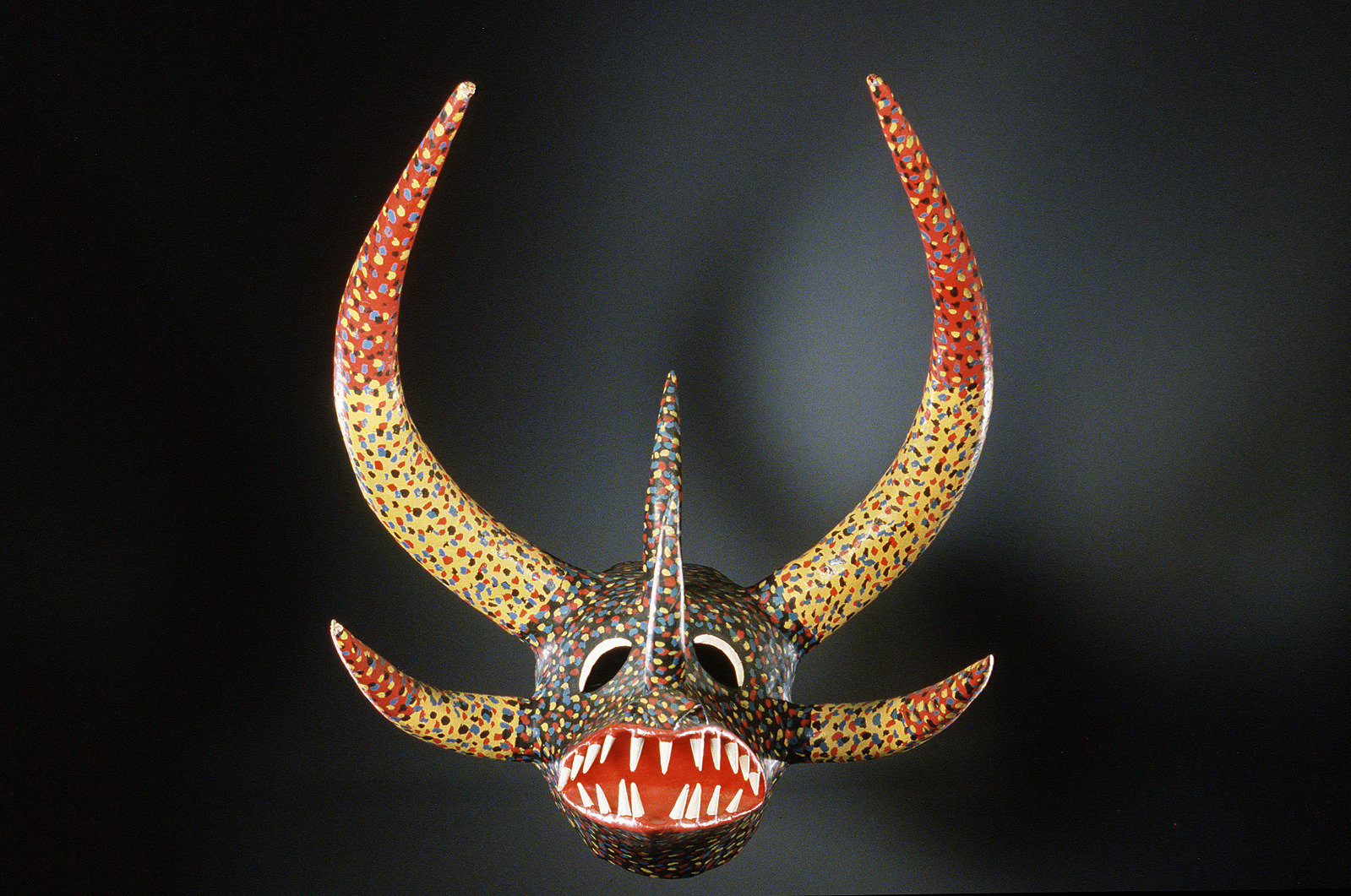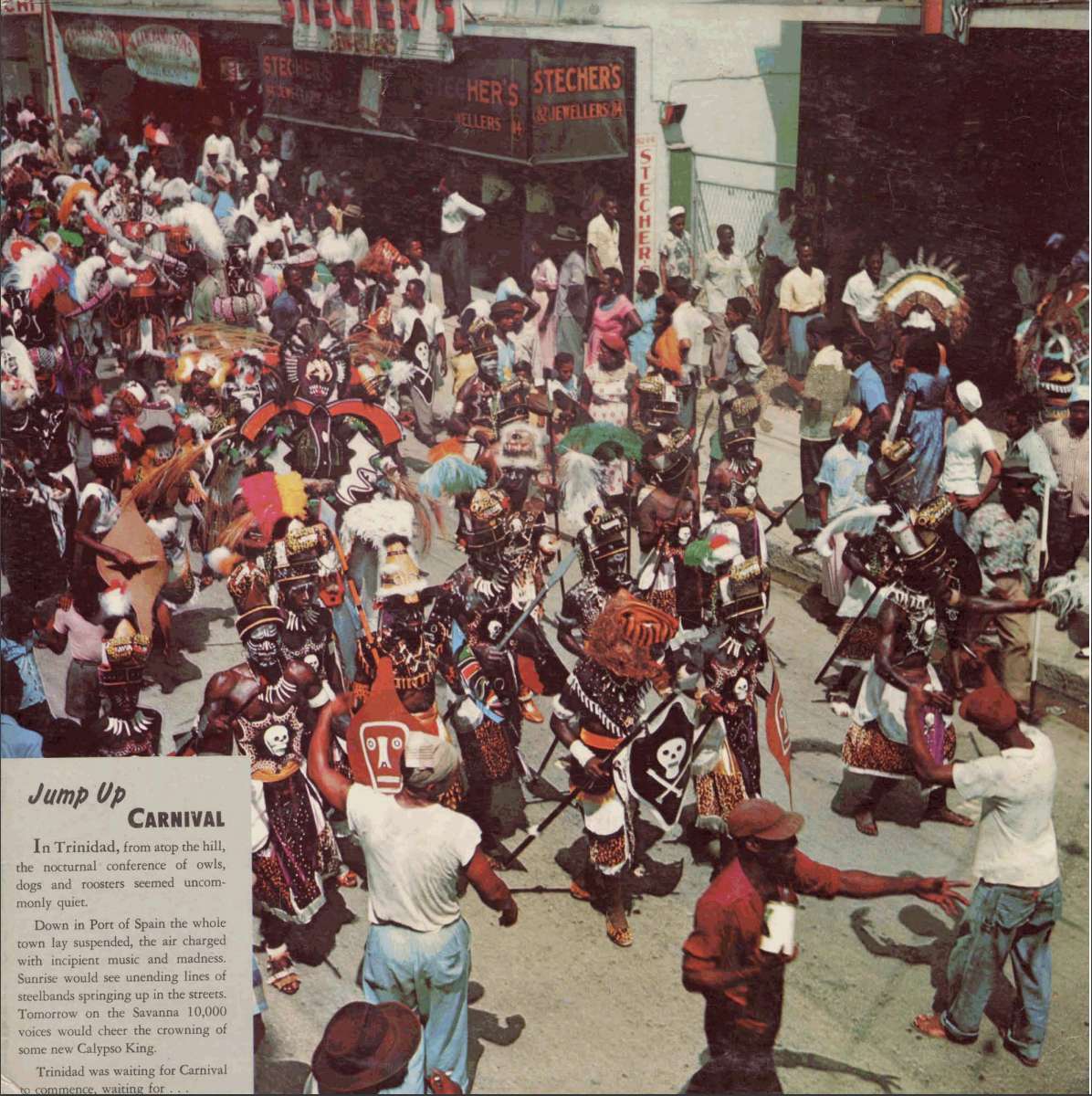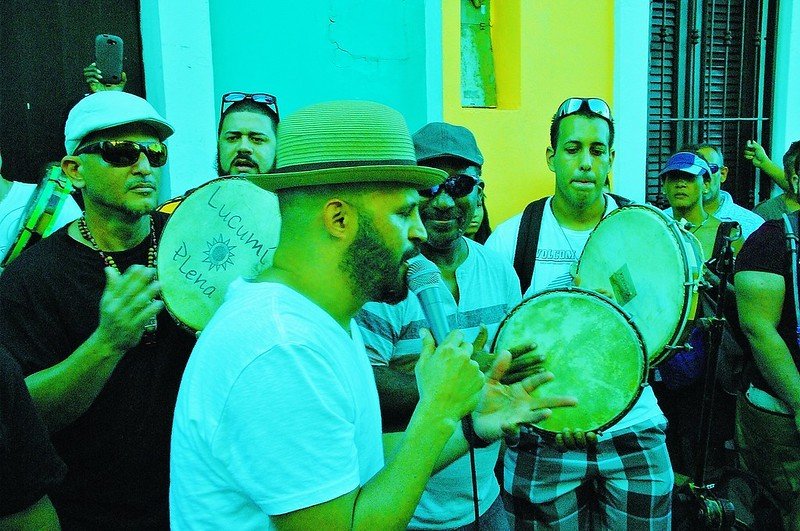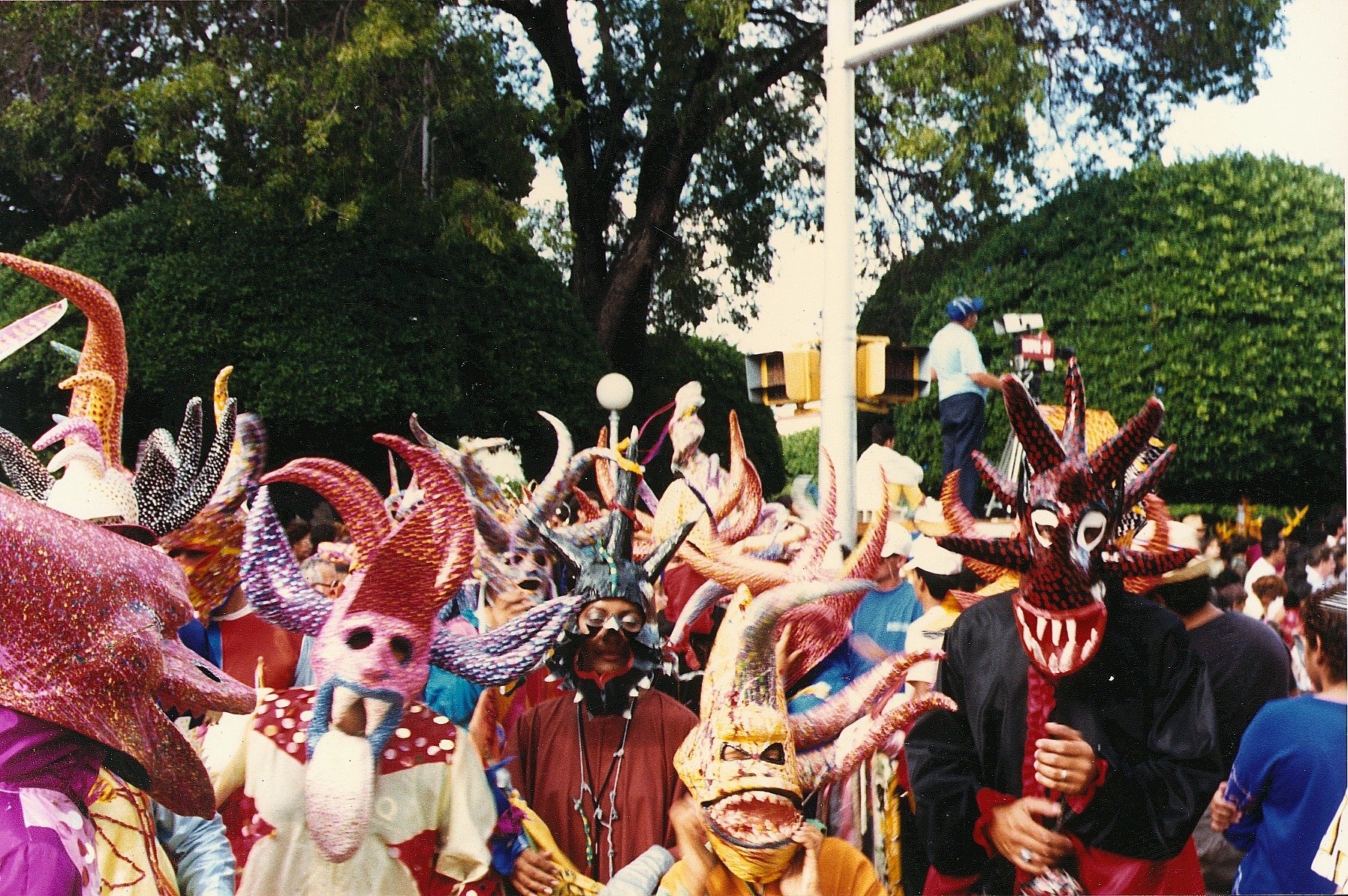
Fiesta Aquí, Fiesta Allá: Music of Puerto Rico
Lesson 8
Vejigante a la Bolla: Carnival in Puerto Rico and Beyond

What is Vejigante a la Bolla?

Vejigante Performers in Front of a Streetlight, unknown photographer. National Museum of American History.
Component 1
Carnival in the Caribbean, Latin America, and Beyond

Vejigante a la Bolla: Carnival in Puerto Rico and Beyond
CREATIVE CONNECTIONS
HISTORY & CULTURE
30+ MIN
Component 2
Celebrating Carnival in Puerto Rico
30+ MIN
30+ MIN

Component 1


30+ minutes
Carnival in the Caribbean, Latin America, and Beyond

Two Carnival Performers Holding Their Masks, unknown photographer. National Museum of American History.
Carnival!


The southern city of Ponce boasts one of the oldest and largest carnival celebrations in Puerto Rico
(163 years old).
"Carnaval", Ponce, PR. Uploaded by Raymond Upgraded.

The Roots of Carnival



Sidewall (USA) Mardi Gras, unknown artist. Cooper Hewitt, Smithsonian Design Museum.
The Carnival of Venice (Peep-Show), by Martin Engelbrecht. Cooper Hewitt, Smithsonian Design Museum.
An example you might be familiar with is the celebration of Mardi Gras (Fat Tuesday) in New Orleans!
Carnival is a festivity that takes place in many countries around the world, just before the Lenten season...
From the Old World to the New



Performers of a Commedia dell'Arte, by Saverio della Gatta. Cooper Hewitt, Smithsonian Design Museum.
Old World European Pagan and Catholic elements were blended with elements acquired in the new world from Native Indigenous and African peoples.
Some Carnival characters:
- Harlequin (clown trickster)
- Vejigante (dancing devil-trickster)
- Viejo (old-man)
- Loca (crazy woman)
- Rey Momo (king of Carnival, personifies satire and mockery)
In Latin America and the Caribbean, Carnival developed new forms of expression.
Carnival Characters


From Left: La Loca "Crazy Woman". "Viejo" Rubber and Plastic Mask. Photos by Lowell Fiet, Digital Library of the Caribbean. Rei Momo in Brazil, by Olimor, CC0, via Wikimedia Commons. Harlequin Carnival Goer, photo 64384126 © dragoncello | Dreamstime.com.




The Importance of Music and Dance


Carnival Dancer in St. Croix, by Kborer, CC0, via Wikimedia Commons.
Music and dance are essential to Carnival celebrations in Latin American and the Caribbean.
Certain music genres are closely tied to Carnival, such as calypso and soca (Trinidad and other surrounding English-speaking islands), plena (Puerto Rico), conga (Cuba), and samba (Brazil).

Carnival Preparation



Communities pull together to make costumes, masks, music, and food and preparations begin months in advance of the festivities.

Left: Black and White Photo of Miguel Ángel Caraballo and his Son, Miguel, Painting a Mask, unknown photographer. Right: Carnival Mask, by Miguel Ángel Caraballo. National Museum of American History.
Optional Video: Carnival Costumes


Carnival is a source of income for local communities all over the Caribbean.
In this optional video excerpt (18:00 - 19:20), a seamstress in the Dominican Republic shares the story of how she makes money sewing costumes for Carnival.
Throughout the region, there is a stark contrast in the price of costumes and the amount of money invested in Carnival.

Carnival Parade in the Dominican Republic, by GeorgiaFlash. Alamy Stock Photo.
“Living Carnival”


During a Carnival celebration in the Caribbean, there is no differentiation between spectator and performer: All are invited to participate.

Jump Up Carnival, photo by Bob Bollard. Cook Records.
In Trinidad, when you choose to join in, it is called playing "mas".
Listen to the sounds of a Carnival parade, recorded live during in Port of Spain, Trinidad in 1956.
Carnival as an Industry



Kreegorseth - Mystic Guardian of the Amazons, costume by Joseph Lewis. National Carnival Commission of Trinidad and Tobago.
Comparsas (groups of performers) win prizes and prestige at costume and music contests.
In many locations, Carnival has become an industry, with policies and regulations created by national commissions and local/municipal organizing committees.
Carnival as Resistance and Catharsis



For many in Latin America and the Caribbean, Carnival is a cathartic celebration (a way to release strong, oppressed emotions).
Some carthartic / ritualistic practices associated with Carnival involve purging and cleansing / purification, and some represent liberation and freedom.
Vejigante Performers in Front of a Streetlight, unknown photographer. National Museum of American History.
Carnival: Place-Based with Common Elements


La Sardina de Naiguatá on the Burial of the Sardine. Smithsonian Folkways Recordings.
Although Carnival celebrations are specific to place, there are certain common elements and rituals.
This age-old ritual was brought to the new world by European colonizers and is celebrated in carnivals around the Caribbean, Ponce Carnival in Puerto Rico, and coastal city of Naiguatá in Venezuela.
Many Carnivals culminate with
The Burial of the Sardine (El entierro de la Sardina).
Optional: Listen to Naiguatá Carnival Music

Listen to excerpts from two songs from Carnival repertoire in Naiguatá, Venezuela:
Do they sound like Christmas songs to you? Why or why not? What musical characteristics do you notice?
"Potpurri 'Sabor a Navidad'," by La Sardina de Naiguatá
"Parranda Callejera (Street Parranda)" by La Sardina de Naiguatá

Inter-Island Connections: The Virgin Islands


Carnival has contributed to many inter-island connections. The movement of musicians throughout the region facilitates the sharing of culture and traditions.
Stanley Jacobs on the Official Music of the Virgin Islands: Quelbe. Smithsonian Folkways Recordings.
In St. Croix (U.S. Virgin Islands), Carnival is celebrated during the Christmas season. During this time, Quelbe ensembles perform a wide array of music.
Watch this video from Smithsonian Folkways to learn more about quelbe!
More Inter-Island Connections: Cuba


Listen for the instruments shown on this slide.
Conga de Santiago Instruments, photos by Richard Veles. Folkways Records.
In Cuba, Santiago has one of the most vibrant Carnivals in the Caribbean: The sound of Conga music fills the air!
"Conga de Santiago," performed by Conga de los Hoyos de Santiago de Cuba





Carnival and Diaspora


The Caribbean diaspora in the United States celebrates Carnival in many different cities. As an example, the West Indian Day Carnival is celebrated on Labor Day in New York.
Enjoying Notting Hill Carnival 2022, photo by Gerry Popplestone. CC BY-ND 2.0, via Flickr.
The Notting Hill Carnival, celebrated in London England in August, brings together a diversity of Carnival traditions from the Caribbean and Latin America, namely Brazil.

Optional Activity: Mapping Carnival


Locate the different Carnival locations mentioned in this Component on this map.

Caribbean and Central America Map, by Bruce Jones Design. World of Maps.
Optional Activity: Mapping Carnival


- Puerto Rico (Ponce)
- Cuba (Santiago & Havana)
- Dominican Republic
- U.S. Virgin Islands (St. Croix)
- Trinidad (and Tobago)
- Venezuela (Naiguatá)
- New Orleans, US
Caribbean and Central America Map, by Bruce Jones Design. World of Maps.

New Orleans
Havana
Santiago
US Virgin Islands
St. Croix
Naiguatá
Ponce
Learning Checkpoint
- What is Carnival and why is it significant to people in Latin America and the Caribbean?
- What are some common elements of Carnival celebrations around the world?
- What are some music genres associated with Carnival in Latin America and the Caribbean?


End of Component 1: Where will you go next?



Return to Pathway homepage:
Fiesta Aquí, Fiesta Allá: Music of Puerto Rico

Component 2

30+ minutes
Celebrating Carnival in Puerto Rico

Youngster Wearing a Vejigante Mask During Ponce Carnival, unknown photographer. National Museum of American History.


What is Carnival?
An example you might be familiar with is the celebration of Mardi Gras (Fat Tuesday) in New Orleans!
Carnival is a festivity that takes place in many countries around the world, just before the Lenten season.

Enjoying Notting Hill Carnival 2022, photo by Gerry Popplestone. CC BY-ND 2.0, via Flickr.

Vejigante Performers in Front of a Streetlight, unknown photographer. National Museum of American History.


Carnival in Puerto Rico: Beginnings
Some of the first descriptions of Carnival in Puerto Rico date back to the 18th century.

Left: Vejigantes Running Through the Street. Above: Two Vejigantes Walking on the Street. Unknown photographer. National Museum of American History.
Historical sources describe extravagant city festivals that involved:
- masks, fireworks, music and dancing, people playing pranks, and parades/processions—which were a form of public theater.


Carnival in Puerto Rico: Today

Alberto Gonzalez Sign at Ponce Carnival, unknown photographer. National Museum of American History.
Today, Carnivals are celebrated all over the island!

The southern city of Ponce boasts one of the oldest and biggest Carnivals in Puerto Rico.

The Spirit of Carnival


Masked Performer with Zantegeba (Baboon) Mask, Bamako (National District), Mali, photo by Eliot Elisofon. National Museum of African Art.
Although all social classes participate in Carnival, in Puerto Rico and the surrounding area, it can be understood as a reaffirmation of African and Afro-Caribbean heritage.
It celebrates traditions brought from Africa, such as their mask-making, food, music, and rituals.


Vejigantes
Wide View of Ponce Carnival, unknown photographer. National Museum of American History.
The main protagonists of Carnival in Puerto Rico are the vejigantes—devil-like tricksters who roam the streets in groups playing pranks on bystanders and spectators.
Vejigantes wear colorful masks with horns and a jump suit.


Vejigantes


Left: Careta de Vejigante, by Alberto Gonzalez. Middle: Black and White Vejigante (Full Body), unknown photographer. Right: Puerto Rican Vejigante Costume, unknown maker. National Museum of American History.

Vejigantes


Left: Carnival Mask, by Leonardo Pagan. Middle: Black and White Photo of Little Kid Wearing a Mask, unknown photographer. Right: Máscara de Carnaval, unknown artist. National Museum of American History.



The Chaos of Carnival

During Carnival the world is...
upside down
All rules, inhibitions, restrictions, regulations, and hierarchy that determine the course of everyday life are suspended.



Left: "La Loca". Middle: Woman Wearing a "Viejo" Mask. Right: Scary Clown. Photos by Lowell Fiat. Digital Library of the Caribbean.

Smaller Carnival Celebrations in Puerto Rico

Throughout Puerto Rico (and the Caribbean region) there are also many smaller community Carnival celebrations.
Carnaval of Vejigantes de la Playa de Ponce , unknown photographer. Museo de Arte de Ponce.

Programming for these festivals is more community-minded (e.g. mask-making workshops for the public).
Eventually, most of the festivities at these peripheral/rural/barrio celebrations merge with the larger city festivals.

Puerto Rican Carnival Music: Plena


The main instruments in plena music are frame drums of different sizes called panderos, which play interlocking parts.
Panderos Drums Trio and Singer, photo by Angel Xavier Viera-Vargas. CC BY-ND 2.0, via Flickr.
Can you hear the different rhythms played on panderos?
"Maringracia," performed by Viento de Agua

Optional: Play Plena

Practice this basic plena rhythm. Play it with and without the recording.
Plena Rhythm, notated by Karen Howard. The Journal of General Music Education.


Brazilian Carnival Music in Puerto Rico

Batuplena, featuring David Marcano. MEINL Percussion Latinoamerica.
Can you hear how the rhythms played on different instruments come together and interlock?

Other "Masked" Occasions in Puerto Rico

Not all festivals in Puerto Rico that feature masks, music, and revelry occur during the Carnival season.
For example, vejigante masks are an important part of the Santiago Apóstol Festival in Loíza, which is celebrated at the end of July.
Fiestas de Calle San Sebastian, is Puerto Rico’s largest street festival. Though not a Carnival per se, the atmosphere of Carnival permeates the four days of this fiesta.

Vejigante and Caballero at Santiago Apóstol Festival in Loíza, by Jaime O. Bofill Calero.

Communities Unite through Carnival

The Ponce Carnival is just one example of the broader Caribbean Carnival tradition: In many ways, this region can be seen as a community united by a “Carnival culture”, which shares certain traditions related to music, rituals, masks, and food.
Top: Diablos cojuelos de La Vega, Dominican Republic, by Gobierno Danilo Medina, CC BY-NC-ND 2.0, via Flickr. Bottom: Vejigante Performers in Front of a Streetlight, unknown photographer. National Museum of American History.


For a sneak peak of Component 3 (which focuses on calypso music), listen to a steelband (a tradition native to Trinidad) from St. Croix (Virgin Islands) playing a calypso (native to Trinidad) in San Juan, Puerto Rico.
"Island in the Sun", performed by The Invaders Steel Band of St. Croix

Creative Activity Option 1: Make a Mask

Encourage students to complete a creative activity to synthesize their learning from this Component.
Option 1: Make a mask.
Option 2 (directions on the next slide): Create music.





Left: Carnival Mask, by Miguel Ángel Caraballo. National Museum of American History.
Right: Women Wearing a "Viejo" Mask, Below: Cardboard "Viejo" Masks, by Lowell Fiat. Digital Library of the Caribbean.
Creative Activity Option 2: Create Music

1. Practice the plena rhythm shown here:
2. Create your own rhythm for the following chant:
Call: Vejigante a la bolla (The name of Puerto Rico's Carnival tradition).
Response: Pan y cebolla (Bread and onion)
3. Add additional verses.
4. Put it all together and perform.



Learning Checkpoint
- What are vejigantes and what is their role in the Puerto Rico Carnival tradition?
- What is the predominant music genre associated with Carnival in Puerto Rico?
- Why can the Caribbean region be viewed as a community united by "Carnival culture"?

End of Component 2: Where will you go next?


Return to Pathway homepage:
Fiesta Aqui, Fiesta Alla: Music of Puerto Rico

Calypso:
Connecting Communities
Component 3

30+ minutes

Jump Up Carnival in Trinidad, photo by Bob Bollard. Cook Records.



What is Carnival?
An example you might be familiar with is the celebration of Mardi Gras (Fat Tuesday) in New Orleans!
Carnival is a festivity that takes place in many countries around the world, just before the Lenten season.

Enjoying Notting Hill Carnival 2022, photo by Gerry Popplestone. CC BY-ND 2.0, via Flickr.

Vejigante Performers in Front of a Streetlight, unknown photographer. National Museum of American History.



Where is Trinidad?

Trinidad boasts the largest Carnival celebration in the Caribbean!
Can you locate Trinidad on this map?

Caribbean and Central America Map, by Bruce Jones Design. World of Maps.


Trinidad and Tobago


Caribbean and Central America Map, by Bruce Jones Design. World of Maps.


Carnival in Trinidad: Jump Up!

During Carnival in Trinidad, music brings parades to life, moving masses of revelers through the streets of Port of Spain.

What sounds do you hear?
"Steel Band Parade on Frederick Street"


Attentive and Engaged Listening: What is Calypso?
In the Caribbean, calypso is the music style most associated with Carnival.
It first emerged in Trinidad during the 18th century and evolved from a combination of cultural influences.
"Reply to Melody", performed by Mighty Sparrow.



1
2
3
Listen for:
- Lyrics that tell a story
- Upbeat/danceable feel
- Syncopated rhythms
- Two-part structure (verse/chorus)



Calypso Kings: Mighty Sparrow and Lord Melody
The calypso performers known as Mighty Sparrow and Lord Melody kept up a running calypso dual for years.


Calypso singers are the stars of Carnival!
King Sparrow's Calypso Carnival, unknown artist. Cook Records. Mighty Sparrow's given name is Slinger Francisco.
Lord Melody (Fitzroy Alexander), unknown photographer. Cook Records.



Integrating Context: Calypso Tents
During Carnival, nightly live music performances featuring calypso singers (calypsonians) take place in calypso tents.
"Calypso Tent: Carnival", Lord Melody

Performing in a Calypso Tent in Port of Spain, Trinidad, 1956, by Bob Bollard. Cook Records.



Attentive Listening: Steelbands

Calypsos are commonly played by steelbands - a type of musical ensemble born in Trinidad. Steelpans (aka steel drums) are typically made from recycled oil barrels.



What other instruments do you hear?
Left: Steelpan, photo by Andrew Alder, CC BY-SA 3.0,via Wikimedia Commons. Middle: The Steel Drums of Kim Loy Wong, unknown photographer. Folkways Records. Right: Brake Drum. Photo 245386347 © Majormetts | Dreamstime.com.
"Boo Boo Calypso", Kim Loy Wong and his Wiltwyck Steel Band

Integrating Context: Calypso is Everywhere!

Calypso Travels, cover designed by Ronald Clyne, photograph by David Jackson . Folkways Records.
Over time, calypso music travelled. It is now played all over the Caribbean—with each island giving this music its own unique flavor.

It is very much associated with Carnival, and shows up in parades and celebrations throughout the region.


Calypso Connects Communities: Vieques

The Caribbean, by U.S. Central Intelligence Agency. University of Texas Libraries.
In Puerto Rico, one can hear calypso at the Carnival of Vieques.
Vieques is a small island off the eastern coast of Puerto Rico. Its people, culture and traditions have strong ties to both the Puerto Rico and the Eastern Caribbean, especially St Croix and the neighboring Virgin Islands.

Vieques


Optional Videos: Vieques Calypso Brass

Vieques Calypso Brass - "My Donkey", uploaded by ViequesCalypsoBrass.

Vieques Calypso Brass - "Tiny Whiney", uploaded by ViequesCalypsoBrass.

Calypso Connects Communities: Loíza

One can also hear calypso at the famous Fiesta de Santiago Apóstol de Loíza.
- Local Loíza bands perform calypso music on steelpans.
Notably, the iconic Carreton Alegre (Happy Cart) blasts calypso music from loudspeakers, which incites the vejigantes and revelers to dance.

Carretón Alegre During Procession in Loiza, photo by Lowell Fiet. Digital Library of the Caribbean.



Engaged Listening: Calypso Time and Rhythm
Let's return to "Boo Boo Calypso", recorded by Kim Loy Wong and his Wiltwyck Steel Band.
- Move around the room, stepping on the steady beat.
- Silently snap along with the shakers.
- Do #1 and #2 at the same time.
- Clap along with the break drum.
- Pat the common syncopated calypso pattern you learned earlier.
- Improvise your own pattern (tap it on your lap or quietly on your desk/table).
While listening to excerpts from the track:



Attentive Listening: Calypso Chords and Song Structure
Can you identify the repeating chord pattern? (Raise 1 finger for "I", 4 fingers for "IV", and 5 fingers for "V".)
Introduction: Groove introduced
Verse (A)
Can you identify the song structure (different sections)?
Rhythmic Improvisation
Interlude (Groove)
Call and response
Chorus (B)
Melodic Improvisation
Ending (Groove)



Engaged and Enactive Listening: A Calypso Groove
- Practice the rhythmic lines individually (with the recording).
- Practice the groove as a group (with the recording).
- Try it without the recording.
- Add the pitches/chords.



Notated Calypso Groove, created and transcribed by Pete Seeger. Folkways Records. Included in a SFR lesson by Katie Wood. Smithsonian Folkways Recordings.

Creating Calypso
Using what you have learned in this Component, create your own short song—inspired by calypso!
A worksheet is provided, which will help you organize your thoughts as you compose, practice, revise, refine, and perform.



Learning Checkpoint
- Why does calypso serve as a symbol of connection in the Caribbean region?
- What are some important musical features of calypso music?
- What were some rewarding and challenging aspects of creating and performing calypso music?


End of Component 3 and Lesson 8: Where will you go next?





Lesson 8 Media Credits

Audio courtesy of
Smithsonian Folkways Recordings
Video courtesy of
Smithsonian Folkways Recordings
Images courtesy of
National Museum of African Art
Lowell Fiet, University of Puerto Rico
University of Texas at Austin, PCLP Map Collection
Smithsonian Folkways Recordings
Bruce Jones Design
National Museum of American History
Jaime O. Bofill Calero
Museo de Arte de Ponce
National Carnival Commission of Trinidad and Tobago
Cooper Hewitt, Smithsonian Design Museum

© 2022 Smithsonian Institution. Personal, educational, and non-commercial uses allowed; commercial rights reserved. See Smithsonian terms of use for more information.
This Pathway received federal support from the Latino Initiatives Pool, administered by the Smithsonian Latino Center.
For full bibliography and media credits, see Lesson 8 landing page.




